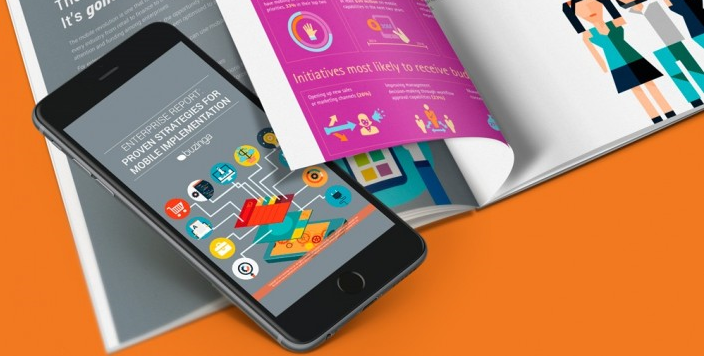6 Simple Principles For Implementing A Bulletproof Mobile Strategy
With its ability to connect various systems on one device, mobile is an essential element of an omni-channel strategy.
For businesses seeking to supercharge their growth, look no further than what’s in your pocket.
With the benefits of increased revenue, higher user engagement, and more efficient data usage, it can’t be denied that mobile is a powerful touchpoint for businesses regardless of industry.
Here are 6 principles for avoiding the most common stumble blocks when implementing a mobile strategy in your business.
-
Identify the key information first
Push through all the needless information you have at your fingertips and focus on what’s important.
For software, the most important initial questions address:
What is the problem your product will solve for users?
Remember, while your objective may be to increase revenue or build a data base, your customers don’t care about these objectives.
You need to find a way to solve a problem for your app users so they will engage with your app, and you in turn can achieve your objectives.
Who are your target users?
Identify app key user groups you plan to target your app for. Then quantify and prioritise these groups, because the app needs to be built to specifically engage these highest priority groups.
Download our user persona template to get started.
How are your target users currently solving the problem?
To create engagement, you need to find a better, more enjoyable, easier, or more rewarding way for your target users to solve the problem.
What are competitor products doing?
If your competitors have an app, identify what they are doing well and not so well.
Also examine how other industries are solving a similar problem. This research can save time and money on a trial & error process.
What are the primary objectives for the first release?
If the primary objective is to validate an idea, then you only need to build the features will provide this validation in the first release – Minimum Viable Product (MVP).
This will reduce time to market and also keep your costs low.
See also: The 3 Step Loop For Delivering Apps On Time & On Budget
How will you determine / measure success?
It is important to determine what success will look like, especially for the first release.
If validation is your objective, then will this be downloads, time spent in the app, specific user feedback, etc.
See also: How To Measure The Success Of Mobile Apps
What is your budget / minimum ROI for first release and updates?
Cost will be determined by complexity.
By first developing a MVP, you will minimise the cost for validation.
However, to continue to develop the product will require a more significant investment in order to realise a significant return.
Your development partner will be able to advise you more accurately for your specific requirements.
See also: Framework For Measuring The Cost & ROI of Enterprise Applications
2. Don’t be a ‘Swiss Army Knife’
In the case of initial mobile strategies, less is more.
When first formulating your product, only include core features and keep the purpose of the product clear for users. This strategy allows you to collect real user data that will inform future, expensive versions.
Once these requirements are agreed upon, ensure they remain as your focus. ‘Swiss army knife’ approaches can fail easily when trying to branch out and take on too much. Your prototype should be customer-focused, and have strong objectives that reflect their needs.
What’s the minimum solution you can build that solves the customer problem?
3. Think like your target user
As you would when rolling out any new product or process, think like the target end-user.
- Why would your target users engage with your app?
- How will you keep them engaged?
- How will you measure their engagement?
- How will you solicit their feedback?
DON’T assume you know your users – Test everything.
The better you get to know your target users and the more effort you make to give them exactly what they want, the more engaged they will be and so the more users you will have.
4. Rome wasn’t built in a day
It’s important that you set realistic expectations for how and when this mobile strategy will impact your business in a noticeable way.
Your prototype won’t be perfect, and that’s ok!
By giving yourself the opportunity to expose limitations, you leave the door open for future improvement. Save the big marketing budget for V2 or V3 release.
Keep your focus on the core features and let your users assist with the rest – you’ll get more objective, valuable insights for improvement than you would brainstorming in an office!
5. Good communication is key
Poor communication derails even the most sophisticated and seemingly simple mobile strategies.
Appoint 1 internal person as Project Manager.
Your internal person responsible for the project should completely understand all the business objectives for the project and be up to date with the development progress.
Their role will be to consolidate all the varying internal requirements and feedback into a single direction/instruction for your developer.
Identify & inform all your key stakeholders.
All client-side individuals or departments with an invested interest in the project outcomes need to be identified and understand what will be required of them.
This concerns issues like timeliness and accuracy of feedback.
Ensure all key stakeholders understand the test plan.
Stakeholders need to be instructed on how to test the beta versions of the app and how to tabulate their feedback.
The best method is to create an internal strategy for a fast and accurate feedback response so that the project is not delayed.
DON’T leave understanding your system to the end.
This can cause serious issues if changes need to be made at the last minute. It will extend release dates and add cost to the project.
6. Trust your Development Partner/Team
When you engage a development partner, they rely on your experience in your industry and with your customers (or staff), to be able to define the problem the app will be solving.
This means that you have the background knowledge when the developer suggest solutions – you are the ‘Subject Matter Expert’.
Your development partner is the technical expert.
Your developer understands how to develop a mobile solution that will engage your target users. This is especially important to understand when it comes to UX, UI and Technical solutions.
DON’T micro-manage the design & development process.
It will usually lead to extended timelines, additional cost and a less-than-optimal product. Transparent collaboration will always net the best results.
Following these 6 key principles will place you in good stead to deliver a high-impact mobile strategy on time and on budget.
Want to learn how Australian business leaders are achieving mobile ROI within 1 year? Download our State of Mobile Report below…
Graham McCorkill
Latest posts by Graham McCorkill (see all)
- Why digital security should be part of every business strategy - April 18, 2017
- How to use Mobile to Disrupt Your Recruitment Game - January 27, 2017
- The 3 Step Loop For Delivering Apps On Time And On Budget - November 11, 2016




